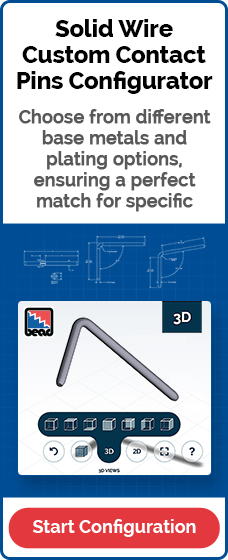How to Dodge Common Failures in Connector Pin Mating
When it comes to electronic assemblies, a single faulty connection can compromise an entire system. Ensuring reliable connectivity between contact pins and standard connectors is critical—especially in high-performance or high-volume applications where even minor errors can lead to costly failures.
As a manufacturer of custom contact pins for over 100 years, Bead Electronics has seen firsthand the most common challenges manufacturers face when mating pins with connectors. Below, we take a look at the top four issues, plus how to proactively avoid them.
Misalignment
The problem: Misaligned contact pins can cause poor or failed connections, leading to increased electrical resistance, intermittent performance, or complete disconnection. This is especially problematic in high-density or multi-pin connectors, where tight tolerances leave little room for error.
The cause: Misalignment is often the result of dimensional inaccuracies in pin geometry, connector housing inconsistencies, or improper assembly practices.
How to avoid it:
- Work with a precision pin manufacturer. Bead’s proprietary manufacturing process ensures dimensional uniformity, reducing the risk of pin skew or misfit.
- Incorporate alignment features. Consider parabolic pin tips to assist with self-alignment during mating.
- Tighten tolerance specs. Collaborate with your supplier to ensure that mating components meet a shared tolerance stack-up strategy.
Excessive Mating Force
The problem: If too much force is required to mate connectors, you risk damaging components, increasing wear, or complicating automated assembly. In worst-case scenarios, connectors can become unusable.
The cause: Mating force issues typically result from oversized contact pins, over-tight insertion fits, or lack of plating uniformity.
How to avoid it:
- Optimized design. Bead can help optimize your pin design to meet insertion force requirements.
- Choose the right material and finish. Plating options like gold or tin can reduce friction and improve mating smoothness.
- Request samples for testing. You may not have to rely solely on CAD data—reach out to Bead to learn more about testing custom contact pins with your connector for real-world compatibility. We might have the stock you need on hand!
Corrosion
The problem: Corrosion degrades the surface of contact pins, compromising conductivity and potentially causing complete electrical failure over time.
The cause: Exposure to moisture, temperature fluctuations, or chemical environments can accelerate corrosion, especially when using base materials or platings ill-suited to the operating environment.
How to avoid it:
- Select corrosion-resistant materials. Gold-plated or nickel-plated contact pins provide excellent resistance in harsh conditions.
- Consider environmental factors. Your connector environment—whether in automotive, aerospace, or industrial applications—should guide your material and finish choices.
- Partner with a supplier that offers plating expertise. At Bead, we offer various finishes to match the demands of any application.

Wear from Repeated Mating Cycles
The problem: In applications where connectors are mated and unmated frequently, mechanical wear becomes a leading cause of failure. This can reduce contact reliability and create inconsistent electrical performance.
The cause: Repeated mechanical friction between pins and connector contacts wears down surface material and can deform pins over time.
How to avoid it:
- Specify high-durability finishes. Gold plating offers excellent wear resistance, especially when paired with a hard underplate like nickel. It's important to use the appropriate gold thickness for the desired mating cycles. For reference:
- Gold Flash (3-6µ"): 50 cycles
- 10µ": 75 cycles.
- 15µ": 100 cycles.
- 30µ": 200 cycles.
- 50µ": 500 cycles
- Design for the duty cycle. Be honest about how often your connectors will be used—this will influence pin material and finish recommendations.
- Test for endurance. Cycle testing can identify early signs of wear and help optimize pin design before going to full production.
Bonus Problem: Overheating & High Resistance
While not always categorized separately, overheating is often the result of high contact resistance, which can stem from any of the issues above: misalignment, corrosion, or wear.
Prevention tip: Always measure resistance during quality testing and ensure your contact pins are designed to handle the electrical load of your application.
Choose the Right Contact Pins for Standard Connectors
If you’re sourcing contact pins to mate with standard connectors, don’t leave it to guesswork. Each application comes with its own set of requirements—from current ratings and cycle counts to environmental exposures and form factors.
At Bead Electronics, we specialize in custom precision pins that meet the exacting standards of connector manufacturers worldwide. With over a century of manufacturing experience and in-house engineering support, we help our customers design contact solutions that reduce failure rates and extend product life cycles.
Need support with your connector challenges? Contact us today to discuss your requirements or request a sample of our precision contact pins!




